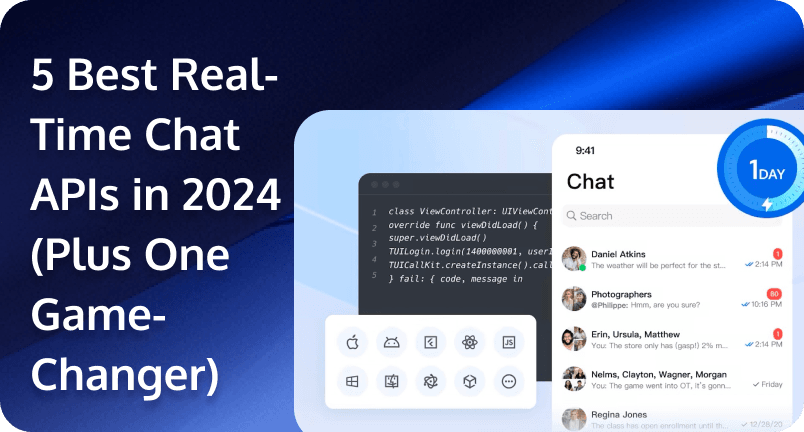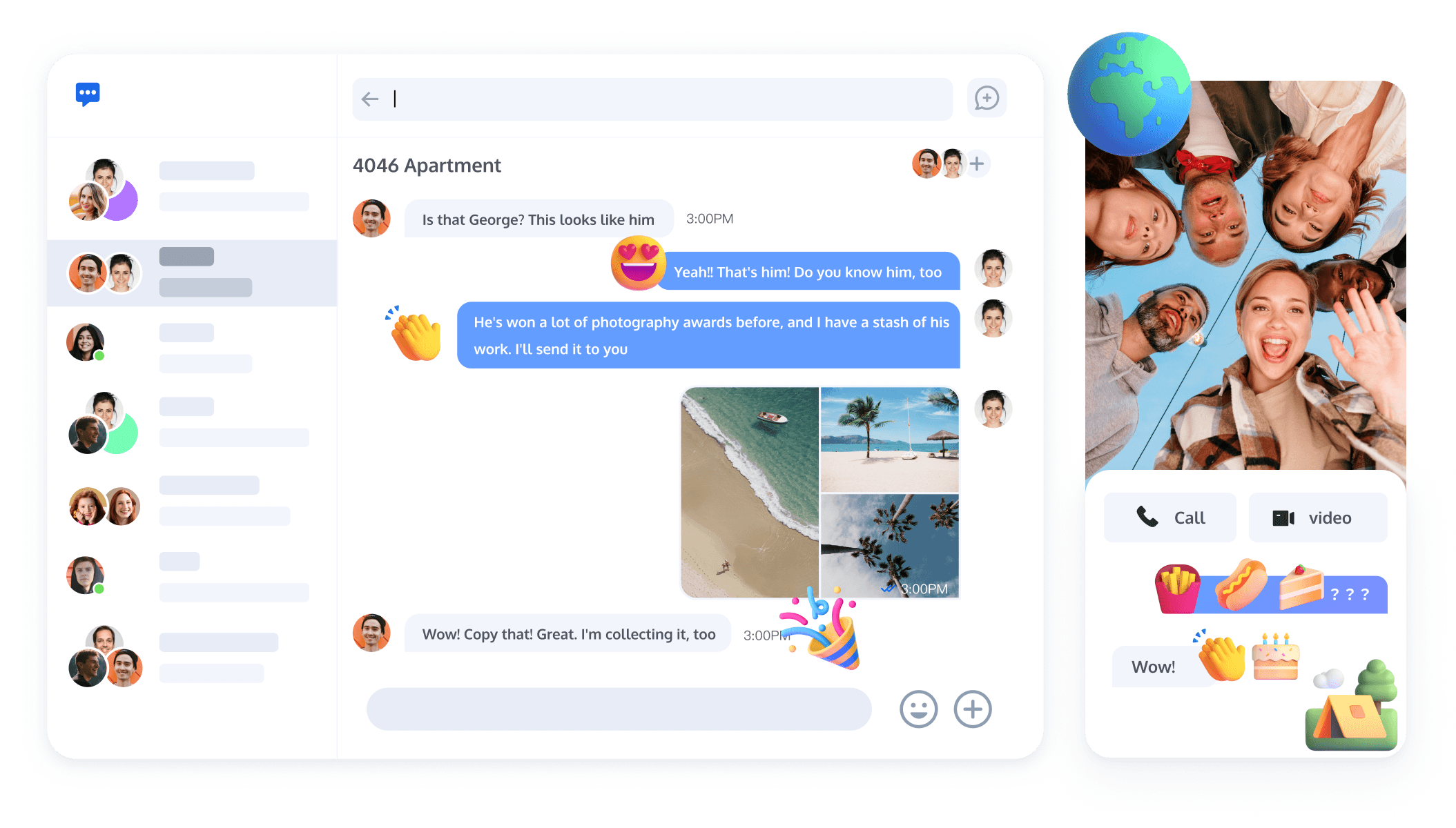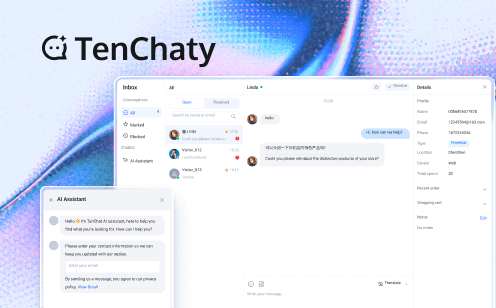5 Best Real-Time Chat APIs and Messaging SDKs in 2024 (Plus One Game-Changer)

In today's digital landscape, real-time chat APIs and messaging SDKs play a crucial role in enhancing customer engagement and communication for businesses. With a plethora of options available, selecting the perfect solution can be a challenging task. This article aims to guide you through the process of choosing the best real-time chat API or messaging SDK, analyzing the top 5 options, and introducing Tencent Chat as an excellent alternative.
What Are Chat APIs and SDKs?
Chat APIs and SDKs enable developers to build web and mobile applications with real-time messaging capabilities quickly and efficiently. They manage the underlying infrastructure required to send and receive messages, along with additional features like typing indicators, online status indicators, and read receipts. A chat API provides direct access to the infrastructure, while a chat SDK offers prebuilt UI components and tools for streamlined development.
What Should You Look for in a Live Chat Solution?
1.Low Latency: Ensure a smooth user experience by minimizing message send and load times.
2.Scalability: The solution should handle increasing user volumes and server loads without compromising performance.
3.Reliability: The solution should provide uninterrupted service and minimize downtime or errors.
4.Guaranteed Delivery: Messages should be delivered exactly once and in the correct order, even in the face of network issues.
5.Elasticity: The solution should dynamically scale resources to accommodate sudden spikes in usage.
6.Rich Features: Offer essential features like typing indicators, online status indicators, read receipts, and push notifications.
7.Integrations: Seamlessly integrate with your existing tech stack to minimize engineering requirements.
8.Data Governance: Ensure compliance with regulatory requirements for data storage, processing, and disposal.
9.Chat Moderation: Maintain a safe and compliant chat environment for both users and operators.
10.Frontend UI: Provide customizable UI components to ensure a cohesive customer experience.
The 5 Best Real-Time Chat APIs and Messaging SDKs
Ably: Best for Reliable Real-Time Experiences Ably is a real-time experience infrastructure provider that offers a comprehensive suite of APIs for building feature-rich and reliable chat applications. Its new chat product, Ably Chat, provides low latency, guaranteed message ordering, and a 99.999% average uptime SLA.
Twilio: Best for Omni-Channel Communication Features Twilio's Conversations API is designed to enable seamless omni-channel messaging experiences across various platforms, including WhatsApp and in-app chats. However, its chat feature set is limited compared to other solutions.
Firebase: Best for Existing Firebase Users Firebase is a comprehensive app development platform that offers real-time database capabilities for storing and broadcasting chat messages. While it may require significant upfront development for advanced chat features, it is an attractive option for existing Firebase users.
Sendbird: Best for a Quick, Out-of-the-Box Chat SDK Sendbird provides a chat SDK with ready-made UI components, enabling developers to quickly integrate chat functionality into their applications. However, its pricing can become opaque at higher scales, and it may have latency issues due to its single data center approach.
Stream (formerly GetStream): Best for a Chat API + UI Kit Offering Stream offers chat APIs and UI components that enable developers to build rich chat experiences with features like typing indicators, user presence, and threaded conversations. However, its single data center can impact latency and reliability.
What Makes Tencent Chat a Game-Changer

Tencent Chat is a powerful and scalable real-time chat solution developed by Tencent, a leading technology company with extensive experience in the messaging industry. Tencent Chat offers the following advantages:
1.Developer-Friendly: With pre-built UI components and templates, developers can quickly integrate Chat functionality into existing applications within hours.
2.Global Access: With its proprietary multi-level optimal addressing algorithm, Chat can perform scheduling across the entire network.
3.Multi-Platform Support: Effortlessly integrate with any platform: Android, iOS, Web, Flutter, React Native, and more.
4.Security on Top: Your data is safe with us. We comply with international data protection standards and employ SSL and AES encryption to protect your information.
5.Flexible and Customizable: Craft your own business with the flexibility of custom UI, webhooks, plugins, and more.
Choosing the right real-time chat API or messaging SDK is crucial for businesses seeking to enhance their communication and customer engagement. While Ably, Twilio, Firebase, Sendbird, and Stream offer various strengths, Tencent Chat stands out as an excellent alternative with its powerful features, scalability, and reliability. Consider Tencent Chat for your next real-time chat project to ensure a seamless and engaging user experience.
Get Started With Tencent Chat
Tencent RTC stands as a robust platform for real-time communication. The service supports high-quality audio and video interactions. Developers can integrate Tencent RTC into web, iOS, Android, and other major development frameworks. Our platform ensures seamless connectivity for users worldwide.
Step 1: Create a project
Create a new React project. You can choose whether to use a TS template or not.
npx create-react-app sample-chat --template typescriptAfter the project is created, go to the project directory.
cd sample-chatStep 2: Download the chat-uikit-react component
Use npm to download chat-uikit-react and use it in your project. Additionally, related open source code is also provided on GitHub, which you can use as a basis to develop your own component library.
npm install @tencentcloud/chat-uikit-reactStep 3: Include the chat-uikit-react component
Note:
- In the following code,
SDKAppID,userID, anduserSigare not input. Acquire the necessary information in Step 4 and replace it accordingly. - npm Integration Method
- Source Code Integration Method
- Replace the content in App.tsx, or you can create a new component for inclusion.
import React, { useEffect, useState } from 'react';
import { ChatSDK } from '@tencentcloud/chat';
import { TUIKit } from '@tencentcloud/chat-uikit-react';
import { TUILogin } from '@tencentcloud/tui-core';
import '@tencentcloud/chat-uikit-react/dist/cjs/index.css';
export default function SampleChat() {
const [chat, setChat] = useState<ChatSDK>();
const init = () => {
const loginInfo = {
SDKAppID: 0, // Your SDKAppID. Get it from Step 4
userID: 'xxx', // Your userID. Get it from Step 5
// UserSig is a cipher for a user to log in to IM. It is the ciphertext generated by
//encrypting information such as userID. Get it from Step 5
userSig: 'xxx', // Your userSig. Get it from Step 5
useUploadPlugin: true,
};
TUILogin.login(loginInfo).then(() => {
const { chat } = TUILogin.getContext();
setChat(chat);
}).catch(() => {});
}
useEffect(() => {
init();
}, [])
return (
<TUIKit chat={chat} language={'en'}></TUIKit> // language support en or zh
)
}Step 4: Create an application
1. Log in to the Chat console.
2. Click Create Application, enter your application name, and then click Create.
3. After creation is complete, you can view the status, service version, SDKAppID, creation time, tag, and expiration time of the new application on the console overview page.
Step 5: Obtain userID and userSig
Click the target application tab, enter the Account Management page, create an account, and obtain userID.
Go to the IM console > UserSig Tools , enter the userID to generate a userSig, and copy the userSig. For more information about userSig, see Generating UserSig.
Step 6: Start the project
Replace SDKAppID, userID, and userSig in App.tsx, and then run the following command:
npm run startNote:
- Ensure that
SDKAppID,userID, anduserSigare successfully replaced in Step 3, as the failure to do so may cause the project to operate abnormally. - A
userIDcorresponds to auserSig. For more information, see Generating UserSig. - If the project fails to start, please check whether the environment requirements are met.
Step 7: Send your first message
1. After starting the project, click + on the left to start a one-to-one chat.
2. Enter the userID created in Step 5 in the search box, and then press Enter.
3. Enter your message in the input box and press Enter to send.


